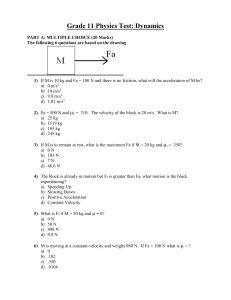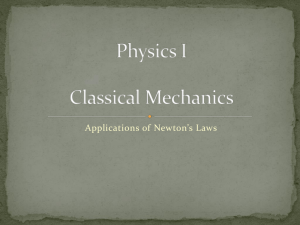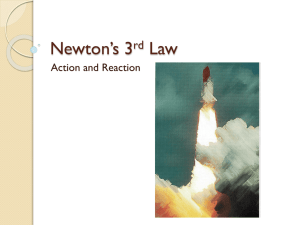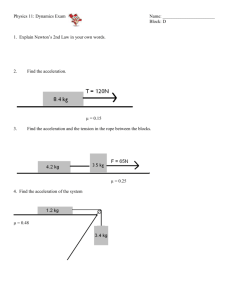Physics I
advertisement
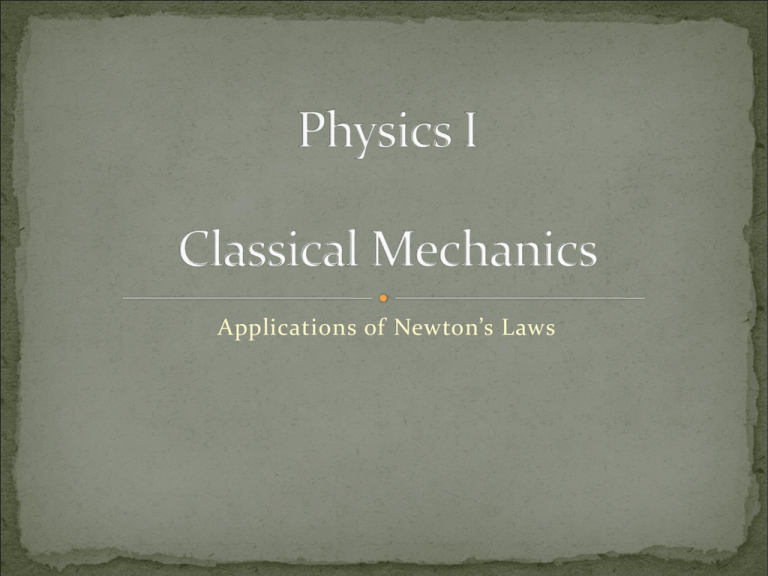
Applications of Newton’s Laws Analytical Numerical diagram computer hands programmation particle 2. negligible magnitude compared to... ->rope, chain with no weight = same T at both ends 3. vector equations become scalar equations in each component using diagram 4. no friction 1. body in equilibrium 1… 2… 3… F 0 ΣFx = 0, ΣFy = 0, ΣFz = 0 dynamics problem, accelerating bodies F ma ΣFx = max , ΣFy = may , ΣFz = maz caution ma is NOT a force! …circular motion 1. v 2 v02 2a (d d 0 ) 2. 3. 4. FBA FAB 1. same magnitude 2. opposite direction 3. act on different bodies 4. no need to only be from the contact surface …normal force, friction force, ?tension in a rope, grav force Gm1m2 Fg 2 r 1. 2. 3. 4. 5. 6. How many bodies? : one diagram for one body How many « acting-on-me » forces are there? : any of them is negligible? Choose the coordinate axes Write a separate equation for each component: number of equations = number of the unknowns Solve! Conclusion : does it make sense? -> special (particular) cases, critical values, generalisation 5-1 One-dimensional equilibrium A gymnast has just begun climbing up a rope hanging from a gymnasium ceiling. She stops, suspended from the lower end of the rope by her hands. Her weight is 500 N, and the weight of the rope is 100 N. Analyze the forces on the gymnast and on the rope. 5-2 Two-dimensional equilibrium A car engine with weight w hangs from a chain that is linked at point O to two other chains, one fastened to the ceiling and the other to the wall. Find the tensions in these three chains, assuming that w is given and the weight of the chains themselves are negligible. 5-3 An inclined plane A car rests on the slanted tracks of a ramp leading to a cartransporter trailer. The car’s brakes and transmission lock are released; only a cable attached to the car and to the frame of the trailer prevents the car from rolling down the ramp. If the car’s weight is w, find the tension in the cable and the force with which the tracks push on the car tires. And if the car is being pulled up the ramp at a constant speed? 5-4 Tension over a frictionless pulley Blocks of granite are being hauled up a 15° slope out of a quarry. For environmental reasons, dirt is also being dumped into the quarry to fill up old holes. You have been asked to find a way to use this dirt to move the granite out more easily. You design a system in which a granite block on a cart with steel wheels (weight w1, including the cart) is pulled uphill on steel rails by a bucket of dirt (weight w2, including the bucket) dropping vertically into the quarry. Ignoring friction in the pulley and wheels and the weight of the cable, determine how the weights w1 and w2 must be related in order for the system to move with constant speed. 5-5 Acceleration in one dimension An iceboat is at rest on a frictionless horizontal surface. What horizontal force F do we need to apply ( along the direction of the runners) to give it a velocity of 6.0 m/s at the end of 4.0 s? The mass of the iceboat and the rider is 200 kg. 5-6 Suppose the motion of the iceboat is opposed by a constant horizontal friction force with magnitude 100 N. Now what force F must we apply to give the iceboat a velocity of 6.0 m/s at the end of 4.0 s? 5-7 Tension in an elevator cable An elevator and its load have a total mass of 800 kg. The elevator is originally moving downward at 10.0 m/s; it is brought to rest with a constant acceleration in a distance of 25.0 m. Find the tension T in the supporting cable while the elevator is being brought to rest. 5-8 Apparent weight in an accelerating elevator A 50.0-kg woman stands on a bathroom scale while riding in the elevator. What is the reading on the scale? n m( g a y ) …4 cases+1 extreme case weightlessness : +excretion of water from RBC-> -volume ->motion sickness 5-9 Acceleration down a hill A toboggan loaded with vacationing students (total weight w) slides down a long, snow-covered slope. The hill slopes at a constant angle α, and the toboggan is so well waxed that there is virtually no friction. What is the toboggan’s acceleration? Does the acceleration depend on the total mass? How can we show that an object lying on a flat floor and a freefalling body are special cases of this problem? What has this problem to do with the famous Galileo’s experiment? 5-10 Two bodies with the same acceleration A robot arm pulls a 4.0-kg cart along a horizontal frictionless track with a 0.50-kg rope, applying a horizontal force with magnitude F = 9.0 N to the rope. Find the acceleration of the system and the tension at the point where the rope is fastened to the cart. (On earth the rope would sag a little; to void this complication, suppose the robot arm is operating in a zero-gravity space station.) What is a system? How can it simplify things? How can we know if the accelerations are the same? When we say two vectors are the same, it means they are the same in both…and…? 5-11 Two bodies with the same magnitude of acceleration An air-track glider with mass m1 moves on a level, frictionless air track in the physics lab. It is connected to a lab weight with mass m2 by a light, flexible, nonstreching string that passes over a small frictionless pulley. Find the acceleration of each body and the tension in the string. What does a light string mean? How does it help to simplify our problem? What does a flexible string mean? How does it help to simplify our problem? What does a nonstreching string mean? How does it help to simplify our problem? Suppose one of the mass is zero at a time to check if you have correctly solve this problem. 5-12 A simple accelerometer A lead fish-line sinker hanging from a string attached to point P on the ceiling of a car. When the system has an acceleration a toward the right, the string makes an angle β with the vertical. In a practical instrument, some form of damping would be needed to keep the string from swinging when the acceleration changes. Given m and β, what is the acceleration a? Why do we call it: accelerometer? Does the mass attached to the string matter? What do we measure in order to know how fast the car is gaining speed? *What kind of engine do you need to see the accelerometer going up higher than 45° in a car with mass of 1.5 ton? *One says you can never see the accelerometer goes up to the parallel level with the ceiling…what do you think? Is it true mathematically? physically? the oil in the car engine, the tires and the road, air drag parachutes, nails, light bulbs, ice hockey, etc. Contact force - normal force - friction force « When you try to slide a heavy box of books across the floor, the box doesn’t move at all unless you push with a certain minimum force. Then the box starts moving, and you can usually keep it moving with less force than you needed to get it started. If you take some of the books out, you need less force than before to get it started or keep it moving. » What general statements can we make about this behavior? Intermolecular forces (electrical) : the bonds form and break Kinetic friction is not perfectly constant Smoothing??? « cold weld » Then how??? You are trying to move a 500-N crate across a level floor. To start the crate moving, you have to pull with a 230-N horizontal force. Once the crate « break loose » and starts to move, you can keep it moving at constant velocity with only 200N. What are the coefficients of static and kinetic friction? Toboggan ride with friction I Let’ s go back to the toboggan we studied in Example 5.10 (Section 5.2). The wax has worn off and there is now a nonzero coefficient of kinetic friction μk . The slope has just the right angle to make to toboggan slide with constant speed. Derive an expression for the slope angle in terms of w and μk. Toboggan ride with friction II The same toboggan with the same coefficient of friction as in Example 5.16 accelerates down a steeper hill. Derive an expression for the acceleration in terms of g, α, μk, and w. Tractive resistance 0.002 - 0.003 for steel wheels on steel rails 0.01 - 0.02 for rubber tires on concrete stick your hand out the window of a fast-moving car carefully! The 3rd law The fluid resistance force : direction? Magnitude? diffefent from the kinetic friction force?? f = kv Air drag f Dv 2 comparing to the rolling resistance… Terminal speed when you drop a rock into the water mg vt k How does the acceleration, velocity, and position vary with time? How are the graphs derived? v y vt [1 e ( k / m)t ] When does vy becoms equal to the terminal speed vt? a y ge ( k / m)t m ( k / m )t y vt [t (1 e )] k mg vt D Terminal speed of a skydiver For a human body falling through air in a spread-eagle position, the numerical value of the constant D in Eq. (5.8) is about 0.25 kg/m. Find the terminal speed for a lightweight 50-kg skydiver. « uniform circular motion » arad v2 R « centripetal acceleration » 2R v T arad 4 2 R T2 v is not constant. 2 2 a arad atan N.B. dv dt and dv dt Fnet marad « centrifugal force » v2 m R Example 5.24 A passenger on a carnival Ferris wheel moves in a vertical circle of radius R with constant speed v. The seat remains upright during he motion. Find expression for the force the seat exerts on the passenger at the top of the circle and at the bottem. Satellites are held in the orbit by the force of our planet’s gravitational attraction. A satellit in a small-radius orbit moves at a higher speed than a satellite in an orbit of large radius. Based on this information, what you can conclude about the earth’s gravitational attraction for the satellite? (i) It increases with increasing distance from the earth. (ii) It is the same at all distances from the earth. (iii) It decreases with increasing distance from the earth. (iv) This information by itself isn’t enough to answer the question. How many are there? What are they?

